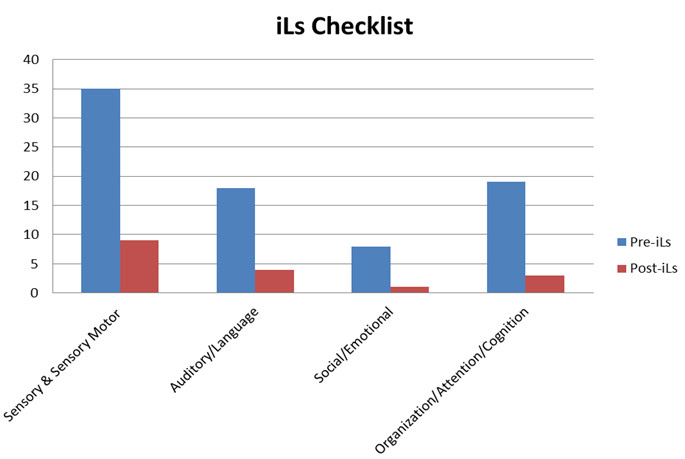Author:
Jill Sengbusch, MA/CCC-SLP, Speech-Language Pathologist, Parkdale Elementary School, NY
Clinician Bio:
Jill is a New York state licensed, ASHA certified Speech-Language Pathologist, with over ten years of experience. She has served the pediatric population in clinic, hospital and school settings.
Abstract:
This case study employed a single-subject design in which iLs was implemented in conjunction with other school-based interventions. The subject, a first-grade student, presented with significant delays in gross and fine motor skills, significant difficulty in early literacy skills, articulation and auditory processing skills. After completing an individualized iLs program, the client saw significant gains in gross and fine motor skills, academics and articulation achieving all of the provider’s and parent’s goals. She increased two reading levels from January to May, and saw an increase from the 4th to 25th percentile in Formulated Sentences, allowing her to better express her ideas with those around her.
Client:
“Kelly”, a 6-year-old female
Background:
Kelly was a first-grade student who demonstrated significant difficulty in early literacy skills, articulation and auditory processing skills such as following multiple-step directions, retaining and recalling auditory information and organizing/sequencing language. Additionally, Kelly showed significant delays in both gross and fine motor skills. In addition to special education instruction in both English Language Arts and Math, Kelly participated in Speech-Language Therapy and Occupational Therapy through the school.
Kelly’s mother reported that peers and unfamiliar listeners found Kelly difficult to understand most of the time, and the family even found Kelly difficult to understand some of the time. Kelly’s teachers and parents report she is a very easy-going child who generally adjusts well to change and does not show frustration, even during difficult academic tasks. Oftentimes, Kelly seems to be unaware of her difficulty and will just wait for help from an adult.
Presenting Problems & Findings:
Sensori-motor Development – rated by parent as normal – rated by educational staff as delayed
- Teachers and staff who work with Kelly observe consistent hand flapping across activities and environments in school.
- Kelly has difficulty with pencil grasp, writing tasks, coordinating gross motor movements.
- Kelly demonstrates overall low tone, with poor posture, hyperextension of limbs, poor core strength, reduced stability and control of muscle movements. Kelly also struggles with coordination of movements.
Auditory Development: No current hearing difficulties reported
Speech-Language Development: Rated by parent as delayed
- First words at 15 months of age.
- Used single words for extended period of time, and had difficulties with articulation at that time.
- Articulation continues to be a significant area of need.
- Understanding of language concepts and use of such were and continue to be delayed. Kelly’s expressive language is unorganized and lacks structure and specific vocabulary.
| Standardized Test | Subtest | Score Type1 | Score1 | |
| Bruininks-OseretskyTest of Motor Proficiency 2nd | Fine Manual Control | Standard Score | 34 (avg=50) | Moderate Delay |
| Fine Motor Integration | Scaled Score | 7 (avg=15) | Moderate Delay | |
| Fine Motor Precision | Scaled Score | 10 (avg=15) | Mild Delay | |
| Manual Coordination | Standard Score | 31 (avg=50) | Moderate to Severe Delay | |
| Manuel Dexterity | Scaled Score | 12 (avg=15) | Average | |
| Upper Limb Coordination | Scaled Score | 4 (avg=15) | Severe Delay | |
| Motor-Free Visual Perception Test | Perceptual Quotient | Standard Score | 110 | N/A |
| Berry-Visual Motor Integration-6th Edition | Visual Motor Integration | Standard Score | 90 | N/A |
Therapeutic Goals:
- Kelly will improve her articulation skills for increased intelligibility.
- Kelly will improve her ability to make sound-letter connections both when decoding and writing.
- Kelly will increase her ability to decode short words and phrases independently.
- Kelly will improve her physical coordination and use of scissors, writing skills.
Parent Goals:
- Kelly will improve her articulation.
- Improve understanding of letter sounds.
- Kelly to read more independently.
- Have fun and enjoy learning.
iLs Program Used:
Specialized iLs program, 40 min/day, 5 days/week, on the iLs Pro System with Interactive Language Program (ILP) activities added. Administered in the school.
Summary of Changes:
Kelly has shown overall gains in her body organization and motor planning skills, which has helped to improve her organization of language, articulation and increased social communication. Kelly has also shown significant gains in stamina and overall attention. These improvements have led to increases in overall academics. Academically, Kelly has increased two reading levels. She knows all her letter names and sounds. Standardized reading assessments (AIMSweb) show improvements in her reading accuracy and fluency.

Standardized Assessments:
| Date of Assessment (AIMSwebs) | Words Read Correctly in 1 min |
| January 2014 (pre-iLs) | 7 |
| May 2014 (post-iLs) | 20 |
| Clinical Evaluation of Language Fundamentals (CELF-4) | ||
| Pre-iLs Percentile Rank 6-years, 8-mos of age | Post-iLs Percentile Rank 7-years, 1-mos of age | |
| Concepts & Following Directions | 9 | 37 |
| Word Structure | 25 | 63 |
| Recalling Sentences | 16 | 16 |
| Formulated Sentences | .4 | 25 |
| Word Classes | 91 | 91 |
| Sentence Structure | 25 | 75 |
| Expressive Vocabulary | 25 | 50 |
| Core Language Score | 5 | 32 |
| Receptive Language Core Score | 34 | 63 |
| Expressive Language Core Score | 4 | 32 |
| Language Content Core Score | 39 | 66 |
| Language Structure Core Score | 25 | 42 |
| * Post-iLs all scores were within average range | ||
One of the most significant increases was noted on the “Formulated Sentences” subtest, which looks at Kelly’s ability to create sentences given a picture stimulus. Formulating sentences to express her ideas was one of the most frustrating and most challenging areas for Kelly, which has improved exponentially.
Conclusions and Recommendations:
Kelly began the program very reserved and unsure of listening. It took Kelly approximately two weeks to adjust to the bone conduction at 1.0 and then she no longer commented that her ears “hurt”. As she progressed through her sessions, she began to look forward to listening, and once we entered the activation phase, she was eagerly waiting at the door for me.
When Kelly began the program, she could not independently stand on one foot. She demonstrated significant difficulties with simple motor tasks, such as even coordinating arm movements with respiration for “Even Breathing. Slowly, however, we began to see improvements in these areas, increases in her strength and stamina and overall increased confidence and she recognized herself that she was improving at tasks we asked her to complete.
Kelly was most proud when she was able to do the monkey bars at the playground here at school! It was a huge success for her, and the most notable thing, was that she talked herself through it, with an almost chant-like rhythm to it, saying “reach, together, reach, together” as she did the monkey bars. It was this rhythm and timing that allowed her to navigate the bars successfully. This is the rhythm and timing that she gained through iLs. Kelly can not only stand on one foot, but can do so ON the balance board.
Kelly has made great gains in her overall levels of arousal and awareness of herself; thus, increases in attention have also been noted. Kelly is now a great participant in classroom activities. When she is participating, Kelly uses clearer speech (as her articulation-coordination has improved) and is able to stay on topic and produce utterances that are logical and follow a basic sentence pattern, which is something she struggled with in the past. Kelly has also shown improvements in her ability to use these newly developed language skills in social interactions with peers. She is able to navigate a conversation, taking turns and even attempts to repair communication breakdowns when they occur. This is significant progress for her.
Comments by Ron Minson, MD, iLs Clinical Director:
More than ever before, clinicians and educators are recognizing a connection between academic learning difficulties and a lack of integration within the motor system. They are related. This astute Speech-Language Pathologist was alerted to the value of iLs to improve her reading, academic and speech/language skills by noting the generalized low muscle tone and difficulty with timing and sequencing of motor movements. They are also related. That these motor weaknesses “were paired with her difficulties in learning and language” recognizes that improving organization of the sensory and motor systems will “better prepare her body for higher level cognitive skills”.
A major academic concern was the delay in reading. As strange as it sounds, reading problems are oftentimes not reading problems so much as they are neurological problems. This is likely the reason why more traditional reading remediation methods were not successful helping Kelly overcome her reading difficulty. iLs’ emphasis of the organization of subcortical systems improved neurological function sufficiently to allow the efforts and expertise of the general and special education school teachers, and Speech-Language Pathologist to be processed and integrated.
Among the numerous neurological organs and systems involved in this case, I want to comment on the crucial role of the cerebellum. This ‘little brain’ figures prominently in the improved outcomes achieved. For example, the cerebellum is directly involved in language, reading, eye movement and motor sequencing as well as the rhythm and timing of both language and motor activities. The combined OT, Playbook activities and auditory program all served to improve cerebellar function along with improvements in other neurological systems. Using the Interactive Language Program (ILP) was important to improve and cement expressive language and higher cognitive processing skills. Therefore, this young girl needed a multi-systems approach that addressed the underlying organization of the motor system to realize the gains achieved in the language and cognitive systems. Well done.

